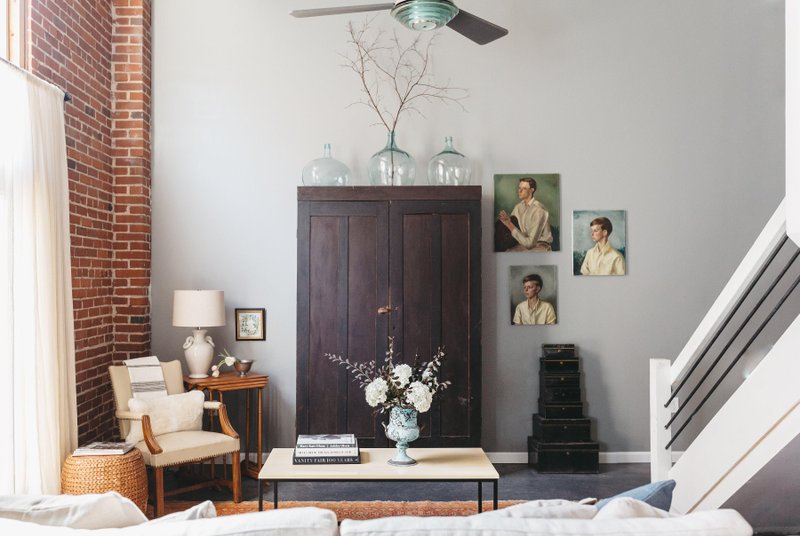Southern or farmhouse style is certainly having a moment. Many homeowners crave a cozy retreat, particularly as the outside world feels increasingly harsh and polarized. And the style, long a staple in rural areas, has become an aspirational look for urban homes as well, in part thanks to HGTV and shows such as Fixer Upper that have brought the aesthetic to a broader audience.
Some would say, though, that the overuse of the look has pushed it into kitsch territory. For anyone who loves those cute sayings and can't imagine a kitchen wall without the stencil proclaiming "Live, Laugh, Love," by all means, you do you. A home should be, first and foremost, a reflection of your own style. But if you want to implement that cozy, rustic style in a subtler, more classic way, listen up.
Kim Leggett, of City Farmhouse in Franklin, Tenn., author of City Farmhouse Style, says the key is to keep things simple, relaxed, natural and unfussy.
"Rooms don't have to be cohesive with each other" in a farmhouse-style home, Leggett says, "and I think that's part of the attraction for designers and homeowners. We're all so busy that when we come home, we want to walk into a space that feels warm and cozy."
Here are her suggestions for creating a comfortable space with a farmhouse vibe — minus the cliches.
SAY NO TO MASS-PRODUCED PIECES
Part of the kitsch problem, Leggett says, is that a lot of big-box retailers sell mass-produced items to capitalize on the farmhouse trend. But in reality, the style is best created with authentic pieces.
"It's just more of a storied approach to design," she adds.
People have been trained to go in that cookie-cutter direction because it's all over social media, Leggett says.
Instead of searching Pinterest or Instagram for inspiration, Leggett suggests turning to books and magazines from 10 to 20 years ago for a more authentic version of the aesthetic. Leggett likes Architectural Digest, Country Living and other shelter magazines, or books such as New Farmhouse Style by Terry John Woods. Then shop local antique shops, flea markets and thrift stores to find items you love. There are also large annual antique shows, such as the Marburger Farm Antique Show in Round Top, Texas, or the Nashville Show in Tennessee, that can yield great finds while doubling as a fun weekend getaway (though getting larger pieces home could be problematic, depending on where you live).
When choosing furniture, go with a minimalist approach, Leggett says. "Farmhouse style is not formal or fussy. Select furnishings that are simple in design with straight lines, kind of like the Shaker-style furniture."
Items made with brown wood are showing up in houses again, Leggett says. "Shunned for years as 'too dated' by designers and home decorators, these classic pieces are making a strong comeback," she says.

KEEP IT NEUTRAL
"Most design mistakes are the result of color," Leggett says. She suggests keeping the walls white. She likes Dune White from Benjamin Moore and Pure White from Sherwin-Williams, saying they work well in both large and small spaces and complement both white and gray upholstery.
Leggett prefers white sofas to keep things light and bright. Although she generally recommends antiques and one-of-a-kind items, this is one area where she says to buy new. You want your seating to be comfortable (to match that laid-back decor), and newer pieces are better for everyday lounging. She shops Pottery Barn and One Kings Lane for Southern/farmhouse-style upholstered seating.
Warm up the neutral walls and furniture with colorful accessories, including pillows (check out the collection from At Home, Leggett says) and area rugs.
"A rug is the best place to start if you want to incorporate some color," Leggett says. Because it's on the floor, it's a little more subtle than putting a bold color on your walls. She likes vintage or Persian rugs with some wear or fading that give the sense that they are timeworn. Shop antique or vintage stores, she says, and look for somewhat muted colors. One Kings Lane also has new and antique rugs.
MAKE TEXTURES AND ACCESSORIES THE STAR
"Accessories are the jewels of the space," Leggett says. But choose them carefully. They should be conversation pieces, rather than generic items bought online.
"You have to get out and visit places where you can find these things," she adds. "The thrill of the hunt is part of the story, and these things will be more meaningful."
But don't go overboard. Choose accessories to create the look of a carefully thought-out space. Instead of a cliche saying, either in a frame or painted on the wall, assemble a collage of old portraits or prints in interesting frames. A special mirror over a large piece of furniture is a great way to create a focal point and make a space seem larger, Leggett says.
The not-going-overboard advice also applies to the current shiplap obsession. Leggett says that although shiplap can add texture while still being fairly minimalist, it should be used sparingly unless it is in a period home. It's more difficult to change than wallpaper or paint, and when the trend fades, it could make contemporary homes look dated. If you want to incorporate some shiplap in your home without overdoing the look, she suggests using it in a kitchen or a bathroom.
When it comes to fabrics, look for natural textiles. "No Southern home would be complete without the warm feel of linen," Leggett says. Use it in table runners, bedding, curtains, place mats, hand towels and more to add muted colors and softness to any room. Check out Rough Linen's online selection of handcrafted textiles, she says.

HomeStyle on 12/14/2019
